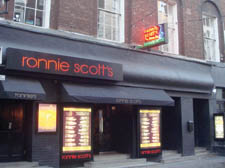|
|
 |
| |

Ronnie Scott’s jazz venue in Gerrard Street |
It’s great Scott’s first 50
Ronnie Scott’s is celebrating a half-century at the legendary venue where two music fanatics gave live jazz a new platform, writes Dan Carrier
A TINY advert in the classified section of Melody Maker appeared on October 23 1959: “Ronnie Scott’s Club, 39 Gerrard Street,” it read, “...Tubby Hayes Quartet; Eddie Thompson Trio and the first appearance of Jack Parnell in a jazz club since the relief of Mafeking.”
The advert, complete with what would soon be recognised as a typical Ronnie Scott joke, concluded that it cost 10 shillings to be a member and admission was 1/6d.
It was the start of an institution that celebrates its 50th birthday this week.
Scott, a tenor sax player, along with fellow saxophonist Pete King, decided in 1959 they wanted a venue of their own and soon found a dingy basement that played host to the biggest jazz names on the planet.
Jazz historian, author and one-time promoter Jim Godbolt edited the club’s in-house magazine for 26 years and has witnessed from off-stage the many antics that took place at the club over the years.
“In a field of activity where the mortality rate is high, this longevity is an enormous achievement,” says Jim, who lives in Lissenden Gardens, Parliament Hill Fields.
He recalls the original club in Gerrard Street, before the move to Frith Street in 1965. “Neither Ronnie or Pete had any idea they would be establishing a national institution with a worldwide reputation, and would be still going five decades hence,” says Jim.
But their secret was they had such a passion for the music – and the banter, and the characters – that opening the club was the natural step.
“It was their love of jazz that inspired them both, they knew full well the hazards and the fact that the history of jazz clubs was littered with early closures,” says Jim.
“It gave them a platform to bring in some of their idols.
“They presented the cream of British jazz as well as booking almost every name from America including Count Basie, Dizzy Gillespie and Stan Getz.”
Jim had been visiting the club since the 1960s, although he was in a different camp: he had been editing a magazine for the “other” jazz venue in London, The 100 Club. There was a major division between those who loved traditional New Orleans-style music and the modernists. The trad-jazz gang would go to the 100 Club, while the modern lovers would meet at Scotts.
“And it wasn’t just about the music, it was a lifestyle thing, too,’ recalls Jim. “The trad lovers would have long hair, breads and sweaters, while Ronnie’s had a different feel.
“At Scott’s, the men wore Cecil Gee suits and coiffured hairstyles: they looked like the performers on stage.”
Despite his 100 Club links, Jim worked for Ronnie’s from 1979 when he asked if they’d consider publishing an in-house magazine, produced with help from George Melly’s pianist Ron Rubin and clarinettist and cartoonist Wally “Trog” Fawkes.
“Pete knew my trad background,” he recalls. “He looked askance at me and being a man of few words, most of them beginning with ‘f’, I was told to be on my way.”
However, they finally agreed to Jim’s idea and he edited the bi-monthly magazine for 159 issues over the next 26 years, chronicling the life and times of Ronnie and Pete, the performers on the stage and the characters in the audience.
Ronnie passed away on Christmas Eve, 1996, but King kept the club going until 2005 until theatre impresario Sally Greene took over, and it is still pretty sprightly for a 50-year-old.
•
|

|
 |
| |
|
 |
|

